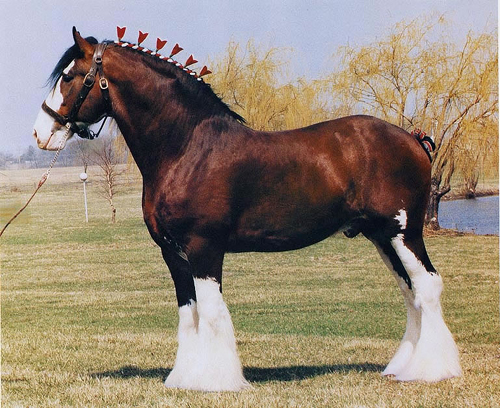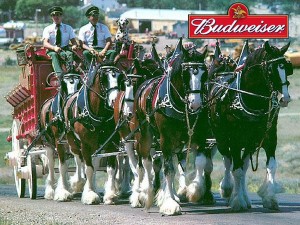
In 1933, August A. Busch, Jr. gave a hitch of Clydesdales to his father in celebration of the resumption of brewing in St. Louis following the repeal of Prohibition. Their first stop was the governor of New York who was responsible or getting the Prohibition repealed. He received a case of Budweiser beer. In 1951 Anheuser-Busch introduced the Clydesdales to TV. Their first commercial ad showed a team of eight horses pulling a beer wagon through the gates of August Busch’s estate (originally the Grant Mansion owned by the father of Ulysses S. Grant).
There are six “hitches” or teams of horses, five that travel around the United States and one that remains in their official home at the company headquarters at the Anheuser-Busch brewery complex in St. Louis, Missouri, where they are housed in a historic brick and stained-glass stable built in 1885. There are eight horses driven at one time, but ten horses are on each team to provide alternates for the hitch when needed. They travel over 100,000 miles a year to make 300 public appearances and delight crowds.
The horses travel in three 18-wheel 50 foot air conditioned tractor trailers along with a three ton red Studebaker wagon made in 1905 and adapted by Busch for beer delivery. And of course the Dalmatian dog that rides on top. Historically, the role of the dogs was to guard the wagon and protect the team while the driver went inside buildings to make deliveries.
The horses are all trained to perform precision docking maneuvers with the wagon. While in the spotlight the horses wear braided manes and tails adorned with ribbons and flowers and handmade harnesses (valued at $5,000 a piece) made of imported leather, silver and brass, weighing in excess of 130 pounds.
 The 200+ matching horses are stabled in St. Louis, Missouri; Menifee, California; San Diego, California; Merrimack, New Hampshire and San Antonio, Texas.
The 200+ matching horses are stabled in St. Louis, Missouri; Menifee, California; San Diego, California; Merrimack, New Hampshire and San Antonio, Texas.
The Clydesdale draft horse originated in the Clyde Valley of Scotland and was bred as a war horse and for its ability to pull large loads. They are known for their 8 foot height, bay color with distinctive white blaze on their face and for the distinctive, feathery hair on their fetlocks–the lower parts of their legs above and behind the hooves. They were introduced to the US after the Civil War as working horses.
You can get a book about the Budweiser Clydesdales HERE.
If you have problems seeing the video below click HERE.
youtube::kgl_hi0dgUw::
